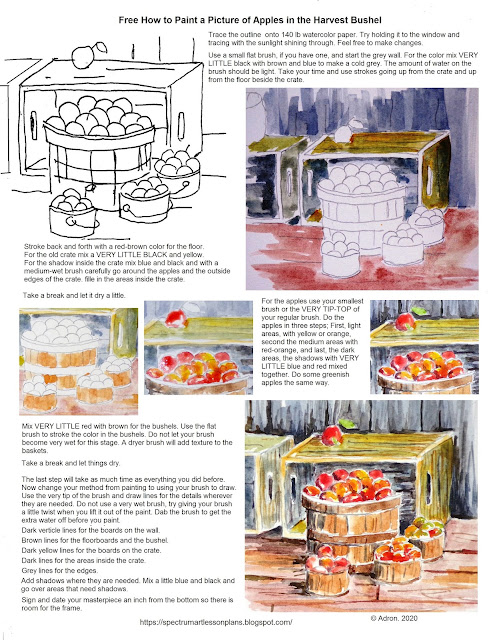Here is a Free How to Paint a Picture Worksheet of Flowers in the Rural Fence
This picture is inspired by a photo I took of some flowers growing beside the path where I walk my dog. They were bright yellow and were growing through the two cross pieces of the fence.
This is a great little project for the beginner. This picture is somewhat simple. It is and not intended to be overly realistic. I always felt if you wanted something as real as a photograph then you should buy a camera. You can use this worksheet as a beginning point and add your own ideas and interpretations, so it is ok if your finished picture does not look like mine. (It might look better).
If you have problems making this worksheet to print CLICK HERE to visit my how-to-print page for some suggestions. or try the updated link below.
 |
| How to Paint a Picture of Flowers on a Fence, Lesson and Worksheet |
My printables are free, so print as many as you like. They take a lot of my time. I often have to create several images before I get the right one for an illustration. It is a lot of work, but I am glad to have the opportunity to inspire others.
I only ask that you consider making a donation. Your gift of support will enable me to create more worksheets for you.
Thank you for your support.
Below is a link to a PDF of the image above.
CLICK HERE for a PDF
SUPPLY LIST
You can use any watercolor paint. I prefer my small Windsor Newton paint set; it has a nice selection of colors. I also use Grumbacher Paints in the tubes. You can easily find these at any craft store like Lobby Hobby or Michaels. (Look for coupons online.) You can collect lots of paintbrushes, but it is better at the start to keep it simple with a few small, medium, and medium-large brushes and a combination of flats as well as rounded paintbrushes. For these art lessons, I use Strathmore series 300 Watercolor paper. It is economical and available at Michaels and Hobby Lobby and online.
PRINTABLE NOTES
Start by tracing the outline of the picture onto 140 lb watercolor paper. If you have trouble seeing it through the paper try holding it to the window and tracing with the sunlight shining through. Do not be too worried to get it right, feel free to make changes.
FIRST WASH
To start use a medium brush and keep the paint watery on the brush. Wash in an even blue for the sky. Wash a light green for the far background on the left, behind the flowers, and the lower area below the post rail.
Save the fun stuff for last, so do not do the flowers until the end. Think of it as a reward for doing a good job on everything else.
SECOND WASH
After the first step has dried.
Mix your color carefully. Make a watery brown-grey by adding a TINY touch of black to brown and a SMALL DAB of red to make a grey color and paint in the brown-grey wood of the fence. You will be adding texture after this wash dries.
Add leafy texture to the foreground, MIx a dark gree using a TINY touch of black and some blue to some green. DONT MAKE IT TOO DARK. Later on, you can mix the darkest green for the deepest shadows. Use a small brush and short strokes to give the texture of a leafy shrub.
Don't add dark treen to the top areas so they look like distant trees.
FOREGROUND PATH
For the dirt path use the watery brown-grey mix and with a lot of water stroke the paint onto the paper using long back and forth strokes. While it is still wet stroke a LITTLE watery blue across the foreground two or three times, then stroke a LITTLE watery grey. Let the colors blend softly.
DEVELOPING DETAILS
After the first layer on the fence has dried, mix a darker brown, with red, and grey. Add dark areas on the shadow side of the fence post and the bottoms of the crosspieces. Don't overdo it.
After the dark areas have dried make another darker black-brown and use the TIP of your brush and DRAW lines for the texture.
FLOWERS- The most important part so take your time!
Yellow is very pale and does not show up much so do not get frustrated. Use the tip of your brush and stork yellow into the flowers. Do not use a very wet brush, try tapping your brush against a tissue to suck the excess water out of it. If the flowers do not show up much try putting a TINY dot of orange at the tip of each petal while the petal is wet, the moisture will draw the orange up and give some distinction between the flower and the background.
AFTER THE YELLOW HAS DRIED mix a little dark brown and use the tip of your brush to dot in the centers of the flowers. After you have done the brown use some black and put a dot or two on the shadowy side of the brown.
Mix a darker green than before and use short downward strokes to add a little darker leafy texture to the shrub.
Sign and date you work but be sure to leave room for a frame.
I hope you create a masterpiece!
(c)Adron.11/1/20
Please consider becoming my patron. Thank You.
Become a Patron!





